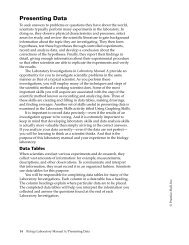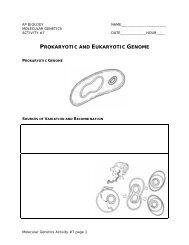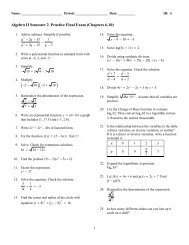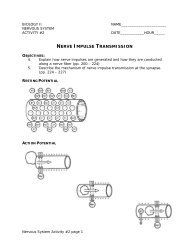Algebra II Semester 2 Practice Final _9 Pages
Algebra II Semester 2 Practice Final _9 Pages
Algebra II Semester 2 Practice Final _9 Pages
You also want an ePaper? Increase the reach of your titles
YUMPU automatically turns print PDFs into web optimized ePapers that Google loves.
Name: ________________________ Class: ___________________ Date: __________ID: AID: A<strong>Algebra</strong> <strong>II</strong> <strong>Semester</strong> 2 <strong>Practice</strong> <strong>Final</strong> Exam (Chapters 6-10)1. Add or subtract. Simplify if possible.q 2 − 2q − 35q 2 + 2q − 15 − 1q − 3q − 8a.q − 3q − 7b.q − 3c. q − 8d.q 2 − 2q − 36q 2 + 2q − 152. Write a polynomial function in standard form withzeros at –4, 2, and –5.a. f(x) = x 3 + 7x 2 + 2x − 40b. f(x) = x 3 + 7x 2 + 2x − 6c. f(x) = x 3 − 3x 2 − 120x − 6d. f(x) = x 3 − 40x 2 + 7x + 23. Simplify.− 10 + 2 4 − 3 10a. 4 10 + 4b. −4 10 + 2 4c. −4 10 + 4d. none of these4. Multiply.Ê ˆ Ê ˆ−2 − 10ËÁ¯˜ −3 + 10ËÁ¯˜a. 16 + 6 10b. −4 + 6 10c. −4 + 10d. −15 − 5 105. Rationalize the denominator of the expression.a.b.7 − 37 + 34 − 2 21410 − 2 214c.−4 − 214d. −16. Write an exponential function y = ab x for a graphthat includes (1, 17.5) and (–1, 2.8).a. y = 2.5(7) xb. y = 5(3.5) xc. y = 7(2.5) xd. y = 3.5(5) x7. Write 2x 3 + 2x 2 – 40x in factored form.a. 2x(x + 5)(x – 4)b. 5x(x – 4)(x + 2)c. –4x(x + 2)(x + 5)d. 2x(x – 4)(x – 5)8. For the function f(x) = (5 − 6x) 2 , find f −1 .a. f −1 (x) =±5 + x65 + xb. f −1 (x) =±6c. f −1 (x) = 5 ± x6d. f −1 (x) = 5 ± x69. Solve. Check for extraneous solutions.6x = 24 − 12xa.23b. −1c.2and −13d. − 2 310. Find the product ( 5x − 3)(x − 5x + 2).a. 5x 4 − 3x 3 + 25x 2 − 5x − 6b. 5x 4 − 3x 3 − 25x 2 + 25x − 6c. 5x 3 − 28x 2 + 25x − 6d. 5x 3 + 22x 2 − 5x − 611. Factor the expression.x 3 − 27a. (x − 3)(x 2 − 3x + 18)b. (x − 3)(x 2 + 3x + 9)c. (x + 3)(x 2 + 3x + 9)d. (x + 3)(x 2 − 3x + 9)12. Solve the equation. Check the solution.53k + 1 k =−38a.3b. − 8 9c. − 169d. − 1 213. Find the center and radius of the circle withequation ( x + 8) + ÊËÁ y − 8ˆ¯˜ = 16.a. (8, –8); 16b. (–8, 8); 4c. (8, –8); 4d. (–8, 8); 1614. Solve the equation.x − 9 − 10 =−5a. 25b. 34c. 16d. 1415. Solve log(3x + 11) = 2.a.893b.1003c. −3d. 8916. Divide using synthetic division.(x 4 − 18x 3 + 44x 2 + 55x − 28) ÷ (x − 4)a. x 3 + 10x 2 + 68x + 41b. x 3 − 18x 2 + 10x + 41c. x 3 − 14x 2 − 12x + 7d. x 3 − 12x 2 + 7x − 1417. Solve the equation. Check the solution.d + 7d − 4 = d − 5d + 2a.13b.179c.175d. − 17518. Divide 4x 3 + 2x 2 − 2x + 3 by x + 3.a. 4x 2 + 14x − 32, R 87b. 4x 2 − 10x + 28c. 4x 2 + 14x − 32d. 4x 2 − 10x + 28, R –81319. Simplify 48a 13 b 12 . Assume that all variables arepositive.a. 2a 4 3b ab. 6a 4 b 4 32ac. 2a 4 b 4 6a3d. none of these12
ID: AID: A20. Use the Change of Base Formula to evaluatelog 462. Then convert log 462 to a logarithm in base2. Round to the nearest thousandth.a. 2.977; log 27.874b. 4.127; log 27.874c. 1.792; log 231d. 2.977; log 23121. Is the relationship between the variables in the tablea direct variation, an inverse variation, or neither?If it is a direct or inverse variation, write a functionto model it.x 0 1 2 3y 0 9923a. direct variation; y = 9xb. inverse variation; y = 9 xc. neither22. Expand the logarithmic expression.log 83d 2a. 3log 8d 2b. log 83 ⋅ 2 log 8dc. log 83 − 2 log 8dd. log 83 + 2 log 8d23. Let f(x) = 4x + 6 and g(x) = 2x + 7. Find(f û g)(5).a. 74b. 26c. 59d. 1724. Rationalize the denominator of the expression.3437a.3287b.31967c.37 28d. none of these25. In how many different orders can you line up 6cards on a shelf?a. 6b. 720c. 120d. 126. Write an equation for the translation of y = −7xthat has the asymptotes x = –2 and y = –7.a. y =−7x − 2 − 7b. y =−7x + 2 − 7c. y =−7x − 7 − 2d. y =−7x + 7 − 227. The values (5.1, 10) and (x, 3) are from an inversevariation. Find the missing value and round to thenearest hundredth.a. 17.00b. 1.53c. 51.00d. 153.0028. Solve 27x 3 + 343 = 0. Find all complex roots.a.7 21 ± 21 3,3 18b. no solutionc. − 7 3 , 7 3d. − 7 21 ± 21i 3,3 1830. Use synthetic division to find P(–4) forP(x) = x 4 + 8x 3 + 2x 2 + 5x − 9.a. –253b. –4c. –73d. 76531. Expand the logarithmic expression.log 48k 4a. log 48 − 4 log 4kb. log 48 + 4 log 4kc. log 48 ⋅ 4 log 4kd. 8log 4k 432. Divide using synthetic division.(x 4 − 12x 3 + 20x 2 + 36x − 45) ÷ (x − 3)a. x 3 − 9x 2 − 7x + 15b. x 3 − 7x 2 + 15x − 9c. x 3 + 6x 2 + 34x + 6d. x 3 − 12x 2 + 6x + 633. Use natural logarithms to solve the equation. Roundto the nearest thousandth.2e 4x + 11 = 22a. 0.426b. –2.151c. 0.300d. 0.70134. Solve the equation.x + 9 − 8 =−4a. –5b. 16c. 25d. 735. Use natural logarithms to solve the equation. Roundto the nearest thousandth.8e 4x + 11 = 30a. 0.216b. 0.409c. 0.092d. –2.42036. Multiply or divide. State any restrictions on thevariables.x 2x − 4 ⋅ x 2 + x − 20x 2 + 4xa.b.c.d.x 2 + 5xx + 4 , x ≠ 4, − 4x 2 + 5x, x ≠ 4, 0, − 4x + 4x + 5, x ≠ 4, 0, − 4x + 4x + 5x + 4 , x ≠ 4, − 437. Write the equation in logarithmic form.4 2 = 16a. log 16 = 2b. log 16 = 2 ⋅ 4c. log 416 = 2d. log 216 = 429. Zach wrote the formula w(w – 1)(2w + 3) for thevolume of a rectangular prism he is designing, withwidth w, which is always has a positive valuegreater than 1. Find the product and then classifythis polynomial by degree and by number of terms.a. 6w 2 ; quadratic monomialb. 2w 5 + w 4 − 3w 3 ; quintic trinomialc. 2w 4 + w 3 − 3w 2 ; quartic trinomiald. 2w 3 + w 2 − 3w; cubic trinomial34
ID: AID: A38. Find the foci of the ellipse with the equation x 29 + y 2= 1. Graph the ellipse.49a. foci (0, ± 2 10) c. foci (0, ± 58)b. foci (0, ± 58) d. foci (0, ± 2 10)41. Use the Pascal’s Triangle to expand the bionomial 42. Multiply or divide. State any restrictions on the(d + 2b) 3 .variables.a. d 3 − 6d 2 b + 12db 2 − 8b 3t 2b. d 3 + 3d 2 b + 3db 2 + b 3c. d 3 − 3d 2 b + 3db 2 − bt + 2 ⋅ t2 + t − 2t 2 − 3t3d. d 3 + 6d 2 b + 12db 2 + 8b 3 t 2 − ta.t − 3 , t ≠ −2, 3b.c.d.t 2 − t, t ≠ −2, 0, 3t − 3t − 1, t ≠ −2, 0, 3t − 3t − 1t − 3 , t ≠ −2, 343. Factor the expression.x 4 − 25x 2 + 144a. (x − 4)(x + 4)(x − 3)(x + 3) c. (x − 4)(x − 4)(x + 3)(x + 3)b. (x − 4)(x − 3)(x 2 ) d. no solution39. Write an equation in standard form of an ellipsethat has a vertex at (–3, 0), a co-vertex at (0, –5),and is centered at the origin.xa.29 + y 225 = 1b.c.d.40. Write an equation for the translation ofx 2 + y 2 = 49, 4 units right and 2 units down.a. ( x + 4) + ÊËÁ y − 2ˆ¯˜ = 49b. ( x − 4) + ÊËÁ y − 2ˆ¯˜ = 49c. ( x − 4) + ÊËÁ y + 2ˆ¯˜ = 49d. ( x + 4) + ÊËÁ y + 2ˆ¯˜ = 49x 25 + y 23 = 1x 23 + y 25 = 1x 225 + y 244. Divide and simplify.3120x 2733x3a. 24x 26b. 2x 8 24x 2c. 5x 2 32x 8d. 2x 8 35x 245. Solve ln(4x − 4) = 8. Round to the nearestthousandth.a. 2,981.958b. 746.239c. 2,976.958d. 744.23946. Simplify.133⋅ 9a. 913b.33c. 3d. 347. Suppose that y varies jointly with w and x andinversely with z and y = 160 when w = 5, x = 24and z = 6. Write the equation that models therelationship. Then find y when w = 4, x = 10 and z= 5.a. y = 6zwx ; 12b. y = 8wxz ; 64c. y = 6wxz ; 48d. y = 8zwx ; 148. Multiply.2Ê ˆ−5 − 3ËÁ¯˜a. 28 + 10 3b. 28 − 10 3c. −13 + 5 3d. 25 − 10 356
66. Multiply or divide. State any restrictions on thevariables.x 2 − 16x 2 + 5x + 6 ÷ x 2 + 5x + 4x 2 − 2x − 8a.b.c.d.(x − 4) 2(x + 3)(x + 1) ; x ≠ − 3, − 1(x + 4) 2 (x + 1); x ≠ − 3, − 2, 4(x + 2) 2 (x + 3)(x − 4) 2; x ≠ − 4, − 3, − 2, − 1, 4(x + 3)(x + 1)1; x ≠ − 4, − 3, − 2, − 1, 4(x + 3)(x + 1)67. Add or subtract. Simplify if possible.w 2 + 2w − 24w 2 + w − 30 + 8w − 5w − 4a.w − 5w 2 + 2w − 16b.w 2 + w − 30c. w + 4w + 4d.w − 568. State the property or properties of logarithms usedto rewrite the expression.log 625x 4 = 1 log 5x5a. Commutative Propertyb. Product Propertyc. Quotient Propertyd. Power PropertyID: AID: Ad. y = 2(5) x 53d. 8 = 3269. Simplify the complex fraction.72. Graph y = 76 () x + 2 + 1.34y − 2 ya. c.1y + 3 2ya.203b. − 1 2c. −2d.32070. Solve the equation. Check the solution.aa 2 − 36 + 2a − 6 = 1a + 6b. d.a. –9b. –6c. –9 and –6d. 671. Write an exponential function for the graph.73. Evaluate the logarithm.74. Write the equation log1328 = 3 in exponential form.log556253a. –3a.532 = 8b. 535c. –4b. 8 = 32a. y = 0.5(2) x32d. 4Ê 3 ˆb. y = 2(0.5) xc.5c. y = (2 ⋅ 0.5) xËÁ¯˜= 81112
ID: AID: A75. State the property or properties of logarithms usedto rewrite the expression.log 56 − log 52 = log 53a. Quotient Propertyb. Product Propertyc. Difference Propertyd. Power Property76. State the property or properties of logarithms usedto rewrite the expression.2log6 + log 1 = log 123a. Power Property and Product Propertyb. Quotient Property and Product Propertyc. Quotient Property onlyd. Power Property only77. Write the expression as a single logarithm.5log bq + 2log bya. log b(q 5 y 2 )b. ( 5 + 2) log Êb ËÁq + yˆ¯˜c. log Ê bq 5 + y 2 ˆËÁ¯˜d. log Ê bqy 5 + 2 ˆËÁ¯˜78. Write the expression as a single logarithm.log 34 − log 3279. Expand the logarithmic expression.nlog 72a. log 7n − log 72b.log 7nlog 72c. log 72 − log 7nd. −n log 7280. Expand the logarithmic expression.57log b74a.12 log 57 + 1 b2 log 74 bb.12 log 57 − 1 b2 log 74 bc. log b57 − log b741d. log b(57 − 74)281. Solve 15 2x = 36. Round to the nearestten-thousandth.a. 0.6616b. 2.6466c. 1.7509d. 1.909182. Use the Change of Base Formula to solve 2 2x = 90.Round to the nearest ten-thousandth.a. 7.6133b. 9.3658c. 3.2459d. 12.983783. Write the expression as a single natural logarithm.3ln3 + 3lnca. ln( 27 + c 3 )b. ln 9c 3c. ln 27cd. ln 27c 384. Find all the real square roots of 0.0004.a. 0.00632 and –0.00632b. 0.06325 and –0.06325c. 0.0002 and –0.0002d. 0.02 and –0.0285. Find the real-number root.3 − 125343a.2549b. − 125343c. − 1251029d. − 5 786. Multiply and simplify if possible.6 ⋅ 2a. 2 3b. 12c. 3 2d. not possible87. Multiply and simplify if possible.ʈ7x x − 7 7ËÁ¯˜a. x 7 − 49 xb. 7x − 49xc. x 7 − x 49d. − 42x88. Divide and simplify.3316223a. 3 3b.3162c.33 3d. 3 389. Divide and simplify.90x 182xa. 3x 8 5xb. 18x 1790. Rationalize the denominator of the expression.Assume that all variables are positive.6x 8 y 9a.b.5x 2 y 4x 3 y 2530y30x 10 y 135x 2 y 4c. 5x 3 y 2 30yd. none of these91. Rationalize the denominator of the expression.Assume that all variables are positive.32 + 3a.b.c.d.3632 632 3632 632 363+ 9 1863+ 3 263+ 9 463+ 3 4692. Add if possible.42 2x4a. 8 4x4+ 6 2x4b. 16 2x4c. 8 2xd. not possible to simplify93. Add if possible.34 3x3a. 9 13x3b. 27 3x3+ 5 10xc. 27 10x3d. not possible to simplifyc. 5x 3x 8d. none of these1314
ID: AID: A94. Subtract if possible.442 5a − 6 5a4a. −20 5a4b. 8 5ac.4−4 5ad. not possible to simplify95. Simplify.120 212⋅ 201a.420b. 20c. 20d. 13896. Write the exponential expression 3x in radicalform.8a. 3 x 38b. 3x 33c. 3 x 8d. 338 8x 397. Solve the equation.2( x − 7)3 = 4a. 11b. 15; –1c. –3d. 1; –198. Solve the equation.11( −2x + 6)5 = ( −8 + 10x)5a.76b.23c. − 1 4d.6799. Let f(x) = −3x − 6 and g(x) = 5x + 2. Find f(x) +g(x).a. 2x – 4b. –8x – 8c. –8x – 4d. 2x – 8100. Let f(x) = x 2 + 2x − 1 and g(x) = 2x − 4. Find2f(x) – 3g(x).a. 2x 2 − 2x − 14b. −3x 2 − 2x − 1c. 2x 2 − 2x + 10d. −3x 2 − 2x − 7101. Let f(x) = x 2 + 6 and g(x) = x + 8 . FindxÊËÁ g û f ˆ¯˜ ( −7).a. − 557b.3847c.29549d.6355102. Find the inverse of y = 7x 2 − 3.a. y =±x + 37b. x =y + 37c. y 2 = x − 37d. y =±x − 37103. For the function f(x) = x + 9, find (f û f −1 )(5).a. 14b. 5c. –5d. 25104. Let f(x) = 4 + 5x and g(x) = 2x − 1. Find f(g(x))and g(f(x)).a. f(g(x)) = 10x – 1; g(f(x)) = 10x + 7b. f(g(x)) = 7x + 3; g(f(x)) = 10x + 7c. f(g(x)) = –7x – 3; g(f(x)) = –10x + 7d. f(g(x)) = –10x – 7; g(f(x)) = 7x + 3106. Graph the function.y = x + 3a. c.b. d.107. Classify –3x 5 – 2x 3 by degree and by number ofterms.a. quintic binomialb. quartic binomialc. quintic trinomiald. quartic trinomial105. Evaluate the logarithm.1log 3243a. –4b. 3c. –5d. 5108. Classify –7x 5 – 6x 4 + 4x 3 by degree and by numberof terms.a. quartic trinomialb. quintic trinomialc. cubic binomiald. quadratic binomial1516
ID: AID: A109. Write the polynomial 6x 2 − 9x 3 + 3in standard3form.a. −3x 3 + 2x 2 + 1b. 2x 2 − 3x 3 + 1c. −3x 3 + 2x 2d. 2x 2 − 3x 3110. Find the zeros of f(x) = (x + 3) 2 (x − 5) 6 and statethe multiplicity.a. 2, multiplicity –3; 5, multiplicity 6b. –3, multiplicity 2; 6, multiplicity 5c. –3, multiplicity 2; 5, multiplicity 6d. 2, multiplicity –3; 6, multiplicity 5111. Divide using synthetic division.(x 3 + 4 − 11x + 3x 2 ) ÷ (6 + x)a. x 2 − 5x, R 70b. x 2 − 5x, R –62c. x 2 − 3x + 7, R 46d. x 2 − 3x + 7, R –38115. Use Pascal’s Triangle to expand the binomial.(s − 5v) 5a. s 5 − 5s 4 v + 10s 3 v 2 − 10s 2 v 3 + 5sv 4 − v 5b. s 5 + 125s 4 v − 1250s 3 v 2 + 6250s 2 v 3 − 15625sv 4 + 15625v 5c. s 5 − 25s 4 v + 250s 3 v 2 − 1250s 2 v 3 + 3125sv 4 − 3125v 5d. s 5 − 25s 4 + 250s 3 − 1250s 2 + 3125s − 3125116. Simplify.− 2 − 2 25 − 6 2a. 7 2 − 10b. −7 2 − 2 25c. −7 2 − 10d. none of these117. Divide and simplify.225x 243xa. 5x 11 3xb. 75x 23c. 3x 5x 11d. none of these112. Solve x 4 − 34x 2 = −225.a. no solutionb. 3, –5c. 3, –3, 5, –5d. 3, –3113. Evaluate the expression.5!a. 24b. 120c. 15d. 720114. Evaluate the expression.7!4! 3!a. 13b. 35c. 79d. 840118. Multiply.2Ê ˆ6 + 5ËÁ¯˜a. 41 − 12 5b. 17 + 6 5c. 36 − 12 5d. 41 + 12 5119. Write 5x 3 – 5x 2 – 30x in factored form.a. 5x(x – 3)(x – 2)b. 2x(x – 3)(x + 5)c. 5x(x + 2)(x – 3)d. –3x(x + 5)(x + 2)3120. Simplify 162a 13 b 6 . Assume that all variables arepositive.a. 3a 4 3b ab. 6a 4 b 2 33ac. 3a 4 b 2 36ad. none of these121. Write an exponential function y = ab x for a graphthat includes (0, 4) and (1, 14).a. y = 7(2) xb. y = 4(3.5) xc. y = 2(7) xd. y = 3.5(4) x122. Simplify.110 3⋅ 100a. 10b. 10c. 100d.31013123. Write a polynomial function in standard form withzeros at –5, –2, and –4.a. f(x) = x 3 + 40x 2 + 11x + 38b. f(x) = x 3 + 11x 2 + 38x + 13c. f(x) = x 3 + 11x 2 + 38x + 40d. f(x) = x 3 + 14x 2 + 240x + 13124. Find the inverse of y = 6x 2 − 2.a. y 2 = x − 26b. y =±c. x =d. y =±x − 26y + 26x + 26125. Solve the equation. Check the solution.k + 5k + 8 = k + 4k − 5a. − 194b. − 7 4c. − 7 12d.741718


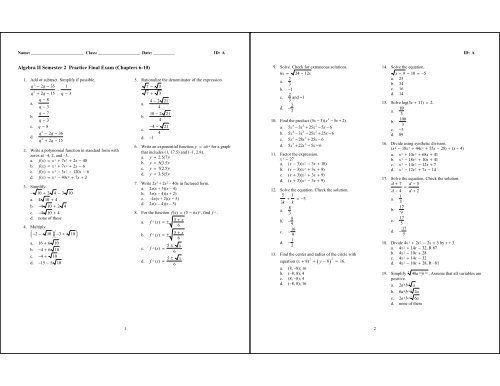
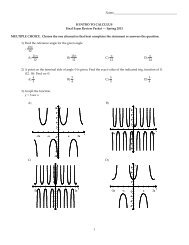
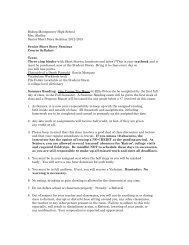
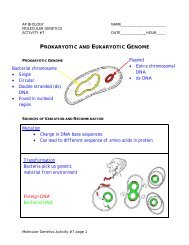


![1. Given: BD is tangent to circle O at C, , and m ACE [A] 41° [C] 40 ...](https://img.yumpu.com/42456754/1/190x245/1-given-bd-is-tangent-to-circle-o-at-c-and-m-ace-a-41a-c-40-.jpg?quality=85)

